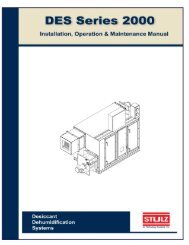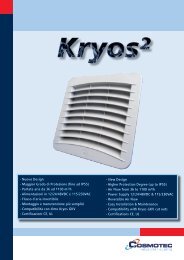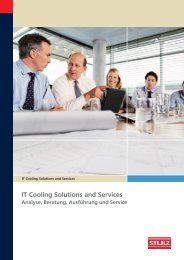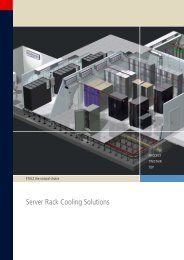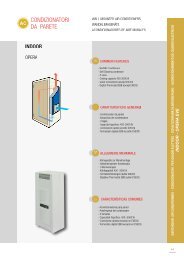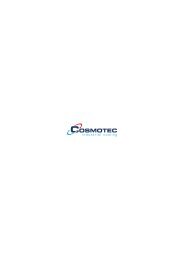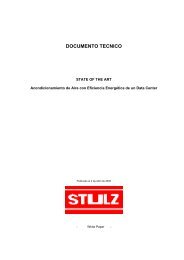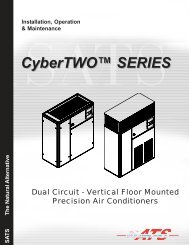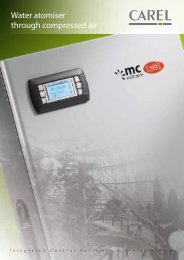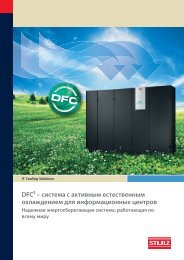Mini-Space Series Installation, Operation & Maintenance Manual
Mini-Space Series Installation, Operation & Maintenance Manual
Mini-Space Series Installation, Operation & Maintenance Manual
You also want an ePaper? Increase the reach of your titles
YUMPU automatically turns print PDFs into web optimized ePapers that Google loves.
<strong>Mini</strong>-<strong>Space</strong> <strong>Series</strong> <strong>Installation</strong>, <strong>Operation</strong> & <strong>Maintenance</strong> <strong>Manual</strong>2.9 System Charging Procedures2.9.1 R22 Refrigerant Charging ProceduresRefrigerant charging procedures vary depending onthe type of refrigerant used in the unit. Before charging,check the unit nameplate to confirm the refrigeranttype. If the unit operates with R22 refrigerant seesection 2.9.1. If R407C is used, see section 2.9.2.NOTERefrigerant charging must be performed by ajourneyman, refrigeration mechanic or an airconditioning technician.2.9.1.1 Self-Contained SystemsAll self-contained water/glycol cooled units (units thatrequire no refrigerant field piping) are factory chargedwith R22. No field charging is required.2.9.1.2 Remote Air Cooled Split SystemsRemote air cooled units are delivered from the factorywith a dry nitrogen holding charge which must beremoved before piping and charging the unit.PREPARING SYSTEM FOR CHARGING1. Once all connections have been made, pressurizethe system to 150 psig with dry nitrogen.Leaks may be detected by checking the standingpressure.2. After ensuring there are no leaks, relieve pressureand evacuate the system. Pull a vacuumof 50 microns or less using the suction anddischarge service ports and the service port ofthe receiver (if applicable). Hold the vacuum for2 hours minimum. Ensure no portion of systemhas been isolated from the evacuation process(liquid, suction or discharge lines).CAUTIONA proper vacuum must be drawn on the refrigerantsystem prior to charging. If this is not done the refrigerantwill combine with the moisture in the pipes toform an acid that will eventually cause compressorfailure.FINE TUNING THE SYSTEM CHARGE2.9.1.2.1 0ºF Fan Cycling and -20ºF VariableSpeed ControlThe following instructions are for charging systemswith condenser fan cycling or variable speed controlusing R22 refrigerant.1. Bleed air from hoses and “break” the system vacuumby supplying R22 vapor. Supply R22 vaporto the suction port until the pressure is raised toabout 50 psig. This small holding charge allowsthe low pressure switch to “make” through outthe process of fi ne tuning the system charge.WARNINGDo not add liquid R22 refrigerant to suctionside of system.2. Referring to Section 3.0, start the system anduse the system controller to lower the temperatureset-point 3-5°F below room temperature.This will ensure the cooling mode stays on duringthe charging procedure.CAUTIONAn adequate heat load must be supplied to theunit to ensure a proper charge.3. Supply R22 vapor to the suction port until theliquid line sight glass is cleared of all bubbles.4. After the unit has stabilized, the liquid line sightglass should be clear and the discharge pressureshould be a minimum of 200 psig. A superheatreading should be taken on the suction line nearthe feeler bulb from the thermal expansion valve,ensuring the temperature-measuring device iswell insulated. The superheat should be approximately12-15ºF. Maximum allowable superheattemperature is 20°F5. A subcooling reading should be taken on theoutput side of the condenser, with the temperaturemeasuring device being well insulated. Thesub-cooling temperature should be approximately10-20ºF.NOTEUnder cold climate conditions it is recommendedto do the following:(©April, 2008)2-14Air Technology Systems, Inc.



